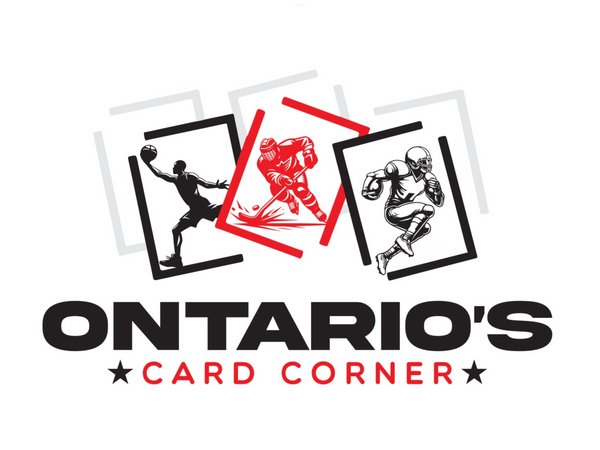“Why Vintage Cards Are Still Worth Collecting” Discuss the enduring appeal of classic cards.
Share
Hello, collectors! Coleman Bennett here, owner of Ontario’s Card Corner. In a world filled with dazzling modern parallels, autographs, and one-of-ones, vintage sports cards still hold a timeless appeal. These classic pieces are more than just collectibles—they’re a window into the history of sports and the evolution of the hobby.
If you’re wondering why vintage cards remain highly sought after, let’s dive into their enduring allure, the factors driving their value, and key terms every collector should know when exploring this fascinating segment of the hobby.
1. The Enduring Appeal of Vintage Cards
A. Historical Significance
-
Vintage cards capture iconic moments and legendary players from past eras. Owning a 1952 Topps Mickey Mantle or a 1979 Wayne Gretzky O-Pee-Chee rookie card is like holding a piece of sports history.
B. Scarcity and Population Count
-
Unlike modern cards, which are produced in massive quantities, vintage cards were often printed in limited runs. Over time, many were lost or damaged, making high-grade examples even rarer.
-
Population Count: Population reports from grading companies like PSA and BGS show how many copies of a specific card exist at each grade level. For example, as of 2025:
-
1952 Topps Mickey Mantle: Only 3 PSA 10 copies exist, making it one of the rarest and most valuable cards ever.
-
1979 O-Pee-Chee Wayne Gretzky Rookie Card: There are just 2 PSA 10s, both of which have sold for over $3 million.
-
1986-87 Fleer Michael Jordan Rookie Card: PSA 10s have a population of 320, and these routinely sell for $200,000 to $400,000.
-
C. Eye Appeal
-
"Eye appeal" refers to the overall visual quality of a card. Even a lower-grade vintage card can command a premium if it has vibrant colors, sharp images, and good centering. Conversely, cards with poor centering or discoloration may be less desirable, even in higher grades.
2. Analytics: The Rising Value of Vintage Cards
Vintage cards have consistently increased in value over the years. Let’s look at the performance of some specific examples:
-
1952 Topps Mickey Mantle:
-
2005: PSA 8 sold for around $30,000.
-
2018: PSA 9 sold for $2.88 million.
-
2022: PSA 9 sold for $12.6 million (a world record).
-
-
1979 O-Pee-Chee Wayne Gretzky Rookie Card:
-
2011: PSA 9 sold for approximately $94,000.
-
2020: PSA 10 sold for $1.29 million.
-
2021: PSA 10 reached $3.75 million.
-
-
1986-87 Fleer Michael Jordan Rookie Card:
-
2010: PSA 10 sold for $19,000.
-
2021: PSA 10 hit $738,000 at auction during the market boom.
-
-
1966 Topps Bobby Orr Rookie Card:
-
2008: PSA 8 sold for $50,000.
-
2023: PSA 9 fetched over $400,000 at auction.
-
3. Key Terms in Vintage Cards
A. Centering
-
Refers to how well the card’s design is aligned within its borders. Poor centering is a common issue in vintage cards and can significantly impact grade and value.
B. Surface
-
Vintage cards are prone to surface issues like scratches, stains, or fading. Clean surfaces with vibrant colors are highly desirable.
C. Topps vs. O-Pee-Chee (Hockey)
-
Topps and O-Pee-Chee produced many of the same hockey cards, but O-Pee-Chee cards were distributed in Canada and printed on thinner stock, making them more susceptible to wear.
-
O-Pee-Chee cards are often rarer and command higher premiums in high grades, particularly for players like Wayne Gretzky and Mario Lemieux.
D. Rounded Corners
-
Many vintage cards, especially pre-1970s, have rounded or worn corners from handling. Cards with sharp corners are highly prized.
E. Low Population
-
Cards with fewer high-grade examples are considered low-population cards. These are often tracked using PSA’s or BGS’s population reports.
4. Why Collect Vintage Cards Today?
A. Stability in the Market
-
Vintage cards tend to have more stable values compared to modern cards, which can fluctuate based on player performance.
B. Broad Appeal
-
Vintage cards attract a wide range of collectors, from sports history buffs to investors.
C. Investment Potential
-
As demonstrated by the analytics above, vintage cards often appreciate over time, especially for legendary players and low-population cards.
5. Tips for Collecting Vintage Cards
A. Focus on Key Players
-
Hockey: Wayne Gretzky, Mario Lemieux, Bobby Orr, Gordie Howe, and Maurice "Rocket" Richard.
-
Baseball: Mickey Mantle, Hank Aaron, Willie Mays, and Babe Ruth.
-
Basketball: Michael Jordan, Bill Russell, Kareem Abdul-Jabbar, and Wilt Chamberlain.
-
Football: Jim Brown, Joe Montana, Jerry Rice, and Walter Payton.
B. Prioritize Condition
-
High-grade cards command a premium, but even mid-grade cards can be excellent investments if they have strong eye appeal.
C. Buy From Trusted Sources
-
Purchase vintage cards from reputable dealers or marketplaces with strong authentication practices. Graded cards provide added assurance of authenticity and condition.
D. Use Population Reports
-
Before purchasing, check population reports to understand the rarity of a card at a specific grade level.
Final Thoughts
Vintage cards offer a perfect blend of nostalgia, history, and investment potential. Whether you’re drawn to the stories behind these classics or the stability they provide in a volatile market, there’s no denying their enduring appeal. At Ontario’s Card Corner, we’re passionate about helping collectors discover the timeless beauty of vintage cards.
If you’re ready to start or expand your vintage collection, reach out to us or visit our table at the next card show. Let’s celebrate the history of the hobby together!
Happy collecting,
Coleman Bennett
Owner, Ontario’s Card Corner
